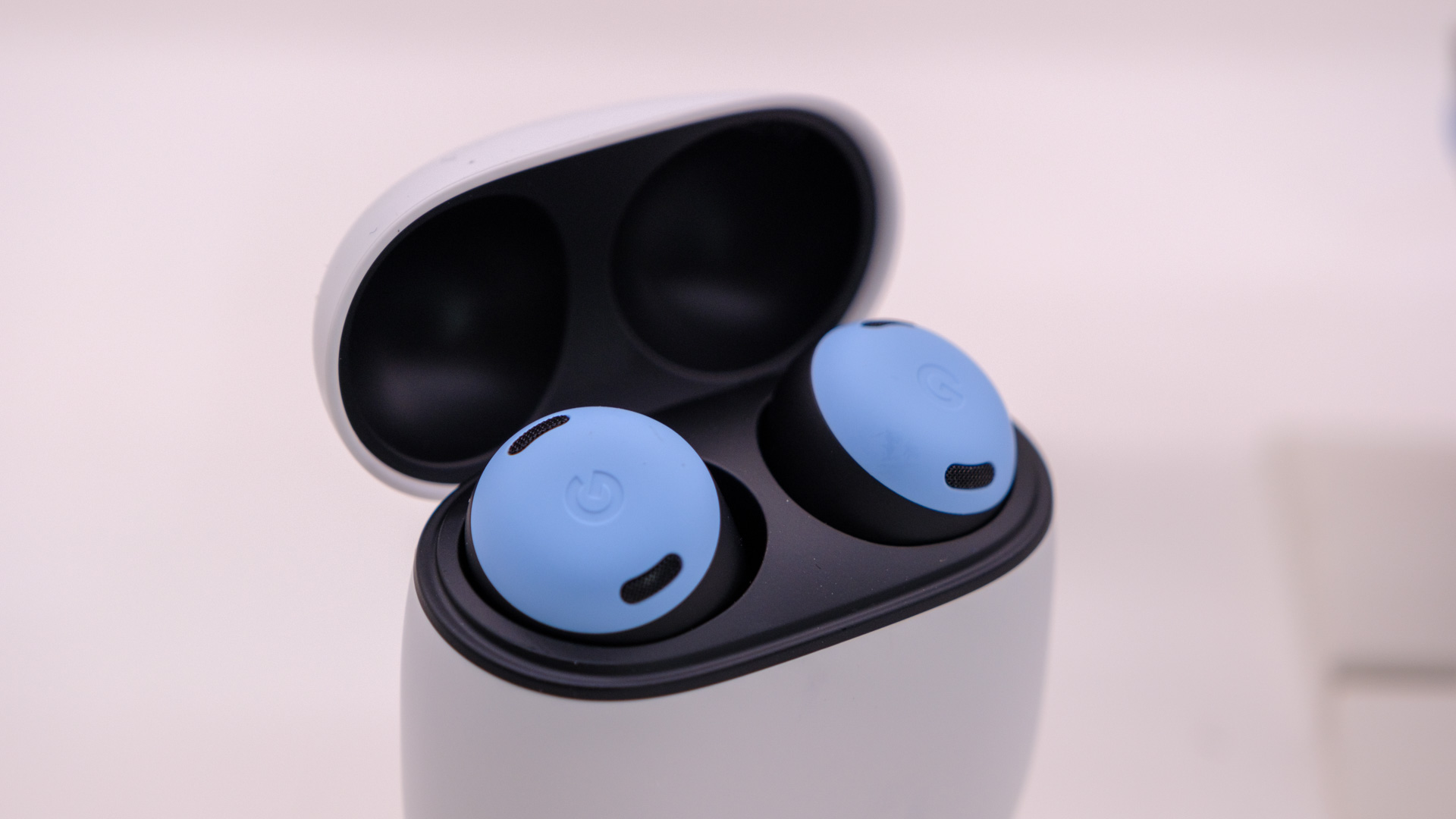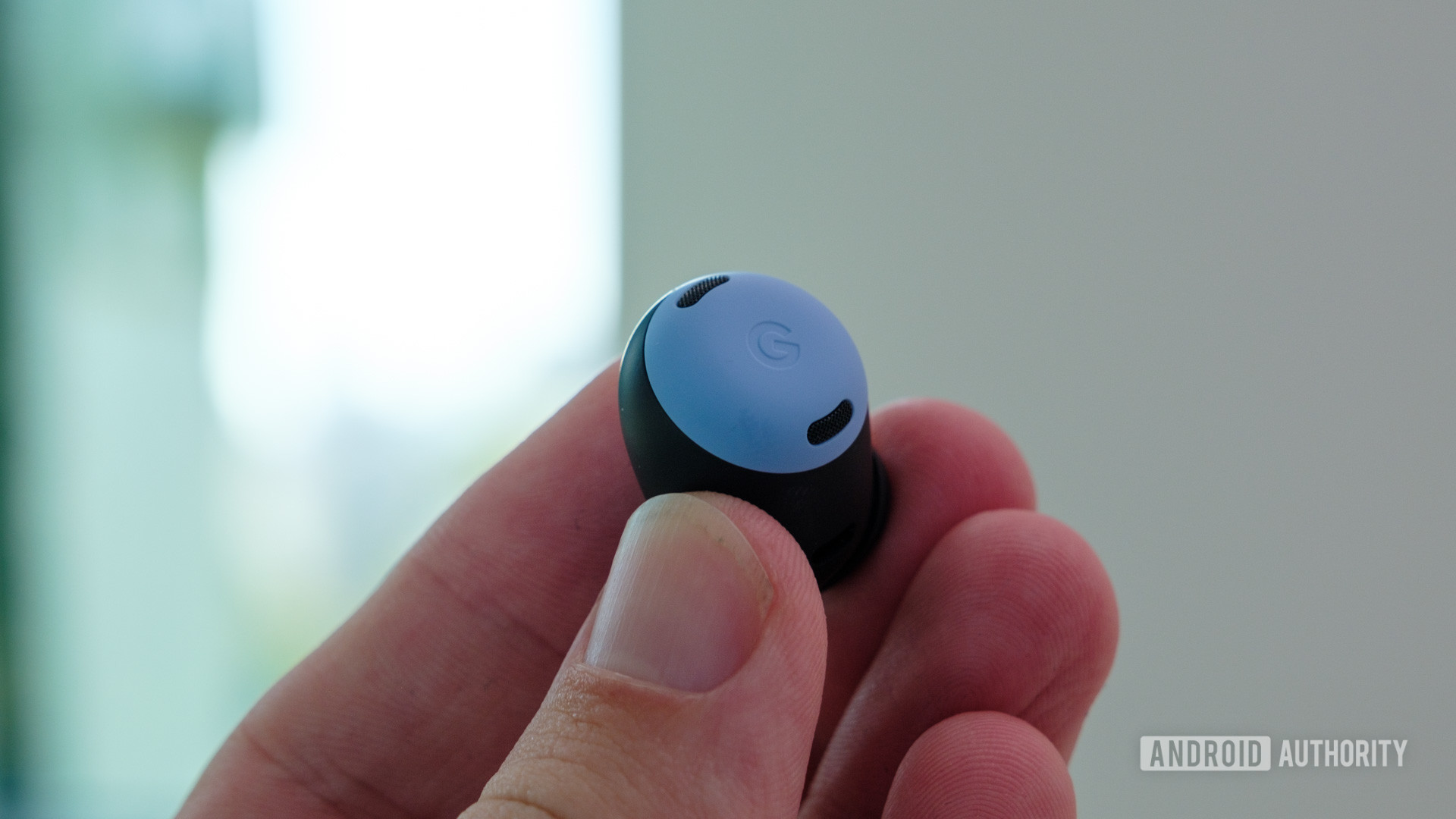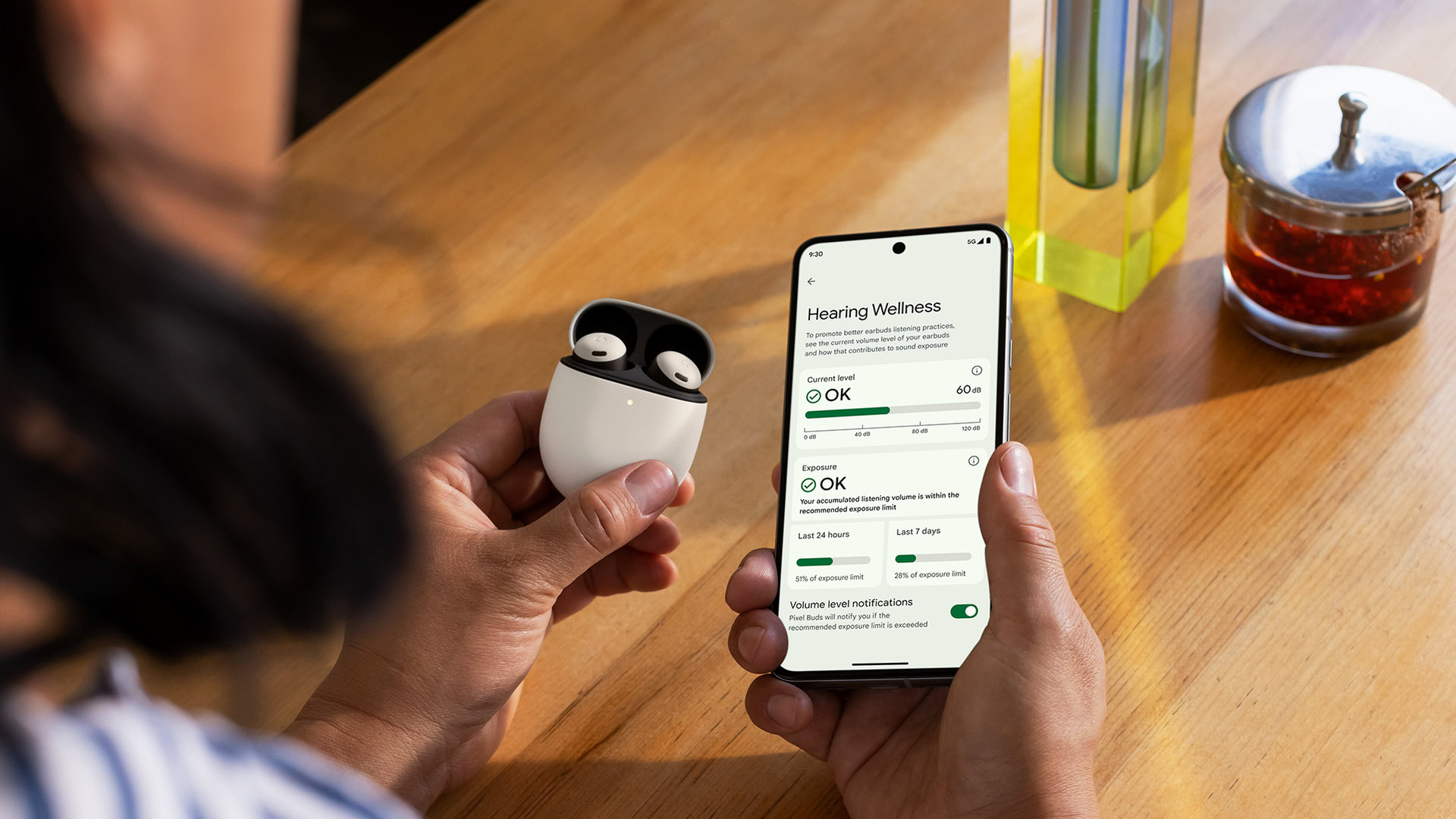
Real Exam Questions and Answers as experienced in Test Center
Google-PDE Braindumps with 100% Guaranteed Actual Questions | https:alphernet.com.au
Google-PDE techniques - Professional Data Engineer on Google Cloud Platform Updated: 2024 | ||||||||
| Real Google-PDE braindumps questions that showed up in test today | ||||||||
 |
||||||||
|
||||||||
|
Exam Code: Google-PDE Professional Data Engineer on Google Cloud Platform techniques January 2024 by Killexams.com team | ||||||||
Google-PDE Professional Data Engineer on Google Cloud Platform A Professional Data Engineer enables data-driven decision making by collecting, transforming, and publishing data. A Data Engineer should be able to design, build, operationalize, secure, and monitor data processing systems with a particular emphasis on security and compliance; scalability and efficiency; reliability and fidelity; and flexibility and portability. A Data Engineer should also be able to leverage, deploy, and continuously train pre-existing machine learning models. The Professional Data Engineer exam assesses your ability to: - Design data processing systems - Build and operationalize data processing systems - Operationalize machine learning models - Ensure solution quality 1. Designing data processing systems 1.1 Selecting the appropriate storage technologies. Considerations include: - Mapping storage systems to business requirements - Data modeling - Tradeoffs involving latency, throughput, transactions - Distributed systems - Schema design 1.2 Designing data pipelines. Considerations include: - Data publishing and visualization (e.g., BigQuery) - Batch and streaming data (e.g., Cloud Dataflow, Cloud Dataproc, Apache Beam, Apache Spark and Hadoop ecosystem, Cloud Pub/Sub, Apache Kafka) - Online (interactive) vs. batch predictions - Job automation and orchestration (e.g., Cloud Composer) 1.3 Designing a data processing solution. Considerations include: - Choice of infrastructure - System availability and fault tolerance - Use of distributed systems - Capacity planning - Hybrid cloud and edge computing - Architecture options (e.g., message brokers, message queues, middleware, service-oriented architecture, serverless functions) - At least once, in-order, and exactly once, etc., event processing 1.4 Migrating data warehousing and data processing. Considerations include: - Awareness of current state and how to migrate a design to a future state - Migrating from on-premises to cloud (Data Transfer Service, Transfer Appliance, Cloud Networking) - Validating a migration 2. Building and operationalizing data processing systems 2.1 Building and operationalizing storage systems. Considerations include: - Effective use of managed services (Cloud Bigtable, Cloud Spanner, Cloud SQL, BigQuery, Cloud Storage, Cloud Datastore, Cloud Memorystore) - Storage costs and performance - Lifecycle management of data 2.2 Building and operationalizing pipelines. Considerations include: - Data cleansing - Batch and streaming - Transformation - Data acquisition and import - Integrating with new data sources 2.3 Building and operationalizing processing infrastructure. Considerations include: - Provisioning resources - Monitoring pipelines - Adjusting pipelines - Testing and quality control 3. Operationalizing machine learning models 3.1 Leveraging pre-built ML models as a service. Considerations include: - ML APIs (e.g., Vision API, Speech API) - Customizing ML APIs (e.g., AutoML Vision, Auto ML text) - Conversational experiences (e.g., Dialogflow) 3.2 Deploying an ML pipeline. Considerations include: - Ingesting appropriate data - Retraining of machine learning models (Cloud Machine Learning Engine, BigQuery ML, Kubeflow, Spark ML) - Continuous evaluation 3.3 Choosing the appropriate training and serving infrastructure. Considerations include: - Distributed vs. single machine - Use of edge compute - Hardware accelerators (e.g., GPU, TPU) 3.4 Measuring, monitoring, and troubleshooting machine learning models. Considerations include: - Machine learning terminology (e.g., features, labels, models, regression, classification, recommendation, supervised and unsupervised learning, evaluation metrics) - Impact of dependencies of machine learning models - Common sources of error (e.g., assumptions about data) 4. Ensuring solution quality 4.1 Designing for security and compliance. Considerations include: - Identity and access management (e.g., Cloud IAM) - Data security (encryption, key management) - Ensuring privacy (e.g., Data Loss Prevention API) - Legal compliance (e.g., Health Insurance Portability and Accountability Act (HIPAA), Children's Online Privacy Protection Act (COPPA), FedRAMP, General Data Protection Regulation (GDPR)) 4.2 Ensuring scalability and efficiency. Considerations include: - Building and running test suites - Pipeline monitoring (e.g., Stackdriver) - Assessing, troubleshooting, and improving data representations and data processing infrastructure - Resizing and autoscaling resources 4.3 Ensuring reliability and fidelity. Considerations include: - Performing data preparation and quality control (e.g., Cloud Dataprep) - Verification and monitoring - Planning, executing, and stress testing data recovery (fault tolerance, rerunning failed jobs, performing retrospective re-analysis) - Choosing between ACID, idempotent, eventually consistent requirements 4.4 Ensuring flexibility and portability. Considerations include: - Mapping to current and future business requirements - Designing for data and application portability (e.g., multi-cloud, data residency requirements) - Data staging, cataloging, and discovery | ||||||||
| Professional Data Engineer on Google Cloud Platform Google Professional techniques | ||||||||
Other Google examsAdwords-Display Display Advertising Advanced ExamAdwords-fundamentals Google Advertising Fundamentals Exam Adwords-Reporting Reporting and Analysis Advanced Exam Adwords-Search Search Advertising Advanced Exam Google-PCA Google Professional Cloud Architect Google-ACE Google Associate Cloud Engineer - 2023 Google-PCD Professional Cloud Developer Google-PCNE Professional Cloud Network Engineer Google-PCSE Professional Cloud Security Engineer Google-PDE Professional Data Engineer on Google Cloud Platform Google-AMA Google AdWords Mobile Advertising Google-ASA Google AdWords Shopping Advertising Google-AVA Google AdWords Video Advertising Google-PCE Professional Collaboration Engineer Google-IQ Google Analytics Individual Qualification (IQ) Google-AAD Google Associate Android Developer Apigee-API-Engineer Google Cloud Apigee Certified API Engineer Cloud-Digital-Leader Google Cloud Digital Leader Google-PCDE Google Cloud Certified - Professional Cloud Database Engineer Professional-Cloud-DevOps-Engineer Google Cloud Certified - Professional Cloud DevOps Engineer | ||||||||
| All you have to do is register at killexams.com if you want to pass your Google-PDE exam at very first attempt. Remove all outdate dumps from your computer and download killexams.com Google-PDE dumps questions and practice test. VCE exam simulator for practicing the Google-PDE braindumps. Now everything you need to pass your exam is with you. You just need to memorize and practice before you take real Google-PDE test. | ||||||||
| Google-PDE Dumps Google-PDE Braindumps Google-PDE Real Questions Google-PDE Practice Test Google-PDE dumps free Google-PDE Professional Data Engineer on Google Cloud Platform http://killexams.com/pass4sure/exam-detail/Google-PDE Question: 230 When a Cloud Bigtable node fails, ____ is lost. A. all data B. no data C. the last transaction D. the time dimension Answer: B Question: 231 Which is not a valid reason for poor Cloud Bigtable performance? A. The workload isn't appropriate for Cloud Bigtable. B. The table's schema is not designed correctly. C. The Cloud Bigtable cluster has too many nodes. D. There are issues with the network connection. Answer: C Question: 232 Which is the preferred method to use to avoid hotspotting in time series data in Bigtable? A. Field promotion B. Randomization C. Salting D. Hashing Answer: A Question: 233 When you design a Google Cloud Bigtable schema it is recommended that you _________. A. Avoid schema designs that are based on NoSQL concepts B. Create schema designs that are based on a relational database design C. Avoid schema designs that require atomicity across rows D. Create schema designs that require atomicity across rows Answer: C Question: 234 Which of the following is NOT a valid use case to select HDD (hard disk drives) as the storage for Google Cloud Bigtable? A. You expect to store at least 10 TB of data. B. You will mostly run batch workloads with scans and writes, rather than frequently executing random reads of a small number of rows. C. You need to integrate with Google BigQuery. D. You will not use the data to back a user-facing or latency-sensitive application. Answer: C Question: 235 Cloud Bigtable is Google's ______ Big Data database service. A. Relational B. mySQL C. NoSQL D. SQL Server Answer: C Question: 236 When you store data in Cloud Bigtable, what is the recommended minimum amount of stored data? A. 500 TB B. 1 GB C. 1 TB D. 500 GB Answer: C Question: 237 If you're running a performance test that depends upon Cloud Bigtable, all the choices except one below are recommended steps. Which is NOT a recommended step to follow? A. Do not use a production instance. B. D. Use at least 300 Gof data. C. Before you test, run a heavy pre-test for several minutes. D. Use at least 300 GB of data. Answer: A Question: 238 Cloud Bigtable is a recommended option for storing very large amounts of ____________________________? A. multi-keyed data with very high latency B. multi-keyed data with very low latency C. single-keyed data with very low latency D. single-keyed data with very high latency Answer: C Question: 239 Google Cloud Bigtable indexes a single value in each row. This value is called the _______. A. primary key B. unique key C. row key D. master key Answer: C Question: 240 What is the HBase Shell for Cloud Bigtable? A. The HBase shell is a GUI based interface that performs administrative tasks, such as creating and deleting tables. B. The HBase shell is a command-line tool that performs administrative tasks, such as creating and deleting tables. C. The HBase shell is a hypervisor based shell that performs administrative tasks, such as creating and deleting new virtualized instances. D. The HBase shell is a command-line tool that performs only user account management functions to grant access to Cloud Bigtable instances. Answer: B Question: 241 What is the recommended action to do in order to switch between SSD and HDD storage for your Google Cloud Bigtable instance? A. create a third instance and sync the data from the two storage types via batch jobs B. export the data from the existing instance and import the data into a new instance C. run parallel instances where one is HDD and the other is SDD D. the selection is final and you must resume using the same storage type Answer: B For More exams visit https://killexams.com/vendors-exam-list Kill your exam at First Attempt....Guaranteed! | ||||||||
|
Celebrate the Holidays with some of SEJ’s best articles of 2023. Our Festive Flashback series runs from December 21 – January 5, featuring daily reads on significant events, fundamentals, actionable strategies, and thought leader opinions. 2023 has been quite eventful in the SEO industry and their contributors produced some outstanding articles to keep pace and reflect these changes. Catch up on the best reads of 2023 to give you plenty to reflect on as you move into 2024. The July 1 migration deadline for Google Analytics 4 (GA4) has passed, and perhaps you’re still feeling unsteady working in the platform, still have some setup to do, or are in the Jumpstart queue. If you’re a reluctant GA4 user or haven’t had the time to get comfortable with it, stick with me as I distill some of the key differences between Universal Analytics (UA) and GA4, highlight what’s new and improved, and share bookmark-worthy resources to amp up your expertise. Whether you’re at an SMB, enterprise, or agency, here are seven tips to help you work faster and get more out of GA4. 1. Know Why GA4 Is So Different From Universal AnalyticsThis may not seem like a tip, but understanding why GA4 came to be and why it’s a departure from UA is key to learning to work with it successfully. GA4 accounts for these two key shifts:
Universal Analytics was built for a time before these shifts, and its methodology was fast becoming outdated and obsolete. GA4 is designed to measure across the web and apps via data streams. While UA reported on individual user sessions, GA4 uses an event-based model that enables unified measurement across user journeys. This is why dimensions and metrics naming conventions often differ and why comparing GA4 and UA reporting can be difficult. Even if you don’t have both a website and an app, you’ll benefit from GA4 because it doesn’t rely on third-party cookies for measurement. 2. Set Up For SuccessIf you’ve been Jumpstarted or migrated yourself but aren’t sure you’ve completed all the steps to customize your property, consider the following. For advertisers, be sure to confirm your Google Ads links imported, validate that your goals and conversions migrated, and that you’re bidding to the right conversions and audiences in Google Ads. You can also quickly bring your UA events into GA4 by selecting the “Collect Universal Analytics events” in your GA4 tag settings. This will create a single GA4 event type that records Category/Action/Label as parameters. You can confirm this works by looking at the Events section under Configure. The GA4 Setup Assistant can help you set up your property. This tool will continue to evolve into a more personalized and comprehensive setup flow in GA4 for all users. And be sure to check out the Setup Guide, which walks through the key steps and concepts for setting up a robust GA4 property for your business, including critical steps for advertisers. 3. Get Your Bearings Before You Dive InPerhaps like you, my first encounters with GA4 were…uncomfortable, to say the least. That is until I spent some time learning and took the Skillshop courses, which provided a solid overview of the foundational concepts and structure of GA4. Whether you’re a beginner or have been working in GA4 for a while, here’s a roundup of Google resources that can help you work faster and smarter:
For more, check out the new learning hub at google.com/analytics/learn with customized learning paths, videos, a link to join the Google Analytics community Discord, and more. Coming soon: You’ll be able to get help finding the info you need right in the UI with a brief page description and valuable actions you can take. 4. Master The Features GA4 Offers That UA Didn’tThere are several new and improved features in GA4 to give you more in-depth insights, more audience capabilities, and save you time. Here’s a rundown of some of the new and improved features in GA4 designed to help novice and advanced users alike get the insights they need. These (SMB-friendly) Features Are New For GA4Business ObjectivesNow when you specify your business objective, that signal is used to automatically surface a tailored set of reports relevant to your goal, such as lead generation, online sales, and brand awareness. You can also find the Business objectives collection in the report Library at any time and add some or all of those reports to your property. Customized Home PageWhile UA showed the same data points to everyone, the new GA4 home page leverages product usage and user signals to customize the experience for you. Analytics IntelligenceThis set of features uses machine learning and rules you set to surface automated and custom analytics insights in several places in GA4 to notify you of any significant changes or emerging trends in your data. Fun Tip: You can type navigational or insights questions directly in the Search bar. Or if you click on it, you’ll see “Ask Analytics Intelligence” suggestions at the bottom, and clicking “More suggestions” will bring up a whole sidebar of questions to get a range of insights in a flash. Enhanced Event MeasurementNo coding required! With enhanced measurement, you can enable events directly in the GA4 interface to measure interactions with your content, such as form interactions, downloads, and video engagement page scrolls. Cross-device/Platform AudiencesBecause GA4 is built for cross-device measurement, it captures and unifies more touch points across the user journey – and can use this data to enhance your advertising audiences. Predictive AudiencesIn UA, Audiences were assembled only based on past behavior without inferences. GA4 uses AI to build predictive audiences, such as users predicted to make a purchase in the next seven days. Note that predictive analytics models do require sufficient data, and you can learn more about predictive metrics and eligibility requirements here. Analytics Audience Builder In Google AdsIn UA, you could create Audiences and import them into Ads, but with GA4, you can create regular and predictive audiences in Ads when you link the accounts. There’s no need to change accounts to leverage audiences in both products. These Improvements Bring More Advanced Capabilities To GA4User-IDIn UA, User-ID was used only in special views and reports. In GA4, User-ID is used throughout reporting to give you the most accurate, user-centric view of customer behavior and journeys. ExplorationsPreviously only available in UA 360, explorations (accessible from Explore in the left-hand navigation) let you dive deeper than the standard reports to better understand customer behavior and your key business metrics. Custom Funnel ReportsPreviously only available in UA 360, custom funnels allow you to see the steps users take to complete a task and evaluate how many users drop off between each step on your website and/or app. You can save funnel explorations to the report Library for quick reference. BigQuery ExportPreviously only available in UA 360, the BigQuery event export is now available to all GA4 users. You can include specific data streams and exclude specific events for each property to control the export volume and BigQuery costs. GMP IntegrationsPreviously only available in UA 360, now you can integrate DV360, Ad Manager, and other Google Marketing Platform products with GA4. App Ecosystem IntegrationsDeep integrations with Firebase, Play, App Campaigns, AdMob, and Ad Manager in GA4 can give you a clearer understanding of user behavior and monetization in your apps. 5. Customize Without CodeA huge plus for resource-strapped businesses is the ability to create and modify events in GA4 without having to make any coding changes. With the Google tag implemented, you can easily create and edit events in GA4. This Help Center page has more details, examples, and video tutorials. GA4 can go beyond Category, Action, Label, Page Views, and Sessions and collect dozens of standard events and any events you customize yourself. This high level of customization makes GA4 incredibly versatile. For example, with the report builder, you can create reports that visualize virtually any combination of dimensions and metrics available. You can then assign filters to reports so that teams in different regions or business units can get insights tailored to their needs. 6. Take Full Advantage Of Ads IntegrationsFor advertisers, GA4 offers a much more robust audience builder than UA. To take full advantage of the audience-building capabilities in GA4, you need to link your Google Ads, Display & Video 360, or Search Ads 360 accounts to your Analytics property and enable personalized advertising. You can then automatically capture, share, and activate tailored audiences in your campaigns. Importing your conversions from GA4 can also provide important feedback to your campaigns and Improve automated bidding performance. Note that you can exclude events or user-scoped custom dimensions from being used for ads personalization in the GA4 interface if desired – no coding is needed. The audiences you define are pre-populated based on the last 30 days of data and evaluated on an ongoing basis. 7. Understand Reporting Identity And Data ThresholdingI see a lot of questions (and frustration) about data thresholds in GA4 reporting. We’ve established that privacy is a core tenet of GA4, which is why you may see data thresholds, depending on the data you’re reporting. Let’s dig into this a bit. GA4 can use four identity methods to unify user touchpoints across devices and platforms into a single user journey: User-ID, Google signals, Device-ID, and Modeling. We’ll get into some more details below, but this is a helpful overview of Reporting Identity to refer back to later. There are three reporting identity options:
If you’re using either the Blended or Observed option with Google Signals enabled, your reports will be subject to data thresholds to protect your users’ anonymity. An orange triangle icon in the top right corner of a reporting card indicates that thresholding has been applied and that data will only show when the minimum aggregation thresholds have been met. Two Key Things To Note About Google Signals And Data Thresholding In GA4
More New Features And Enhancements To ComeGA4 was built for a new era and will continue to evolve. While it’s highly customizable, features like automated insights, more default reports, and the new personalized Home page are designed to help make GA4 more intuitive and useful. Stay tuned for even more updates, particularly in the Advertiser Workspace, and more customization features for SMB customers. And as you work more in GA4, you’re bound to have your own top tips to add to this list! Google and repair outfit iFixit are selling genuine parts for the Google Pixel Pro 8, but the cost of the camera module is quite expensive, roughly the same ballpark as its Apple-based iPhone 14 Pro and iPhone 15 Pro rivals. As an online repair shop, iFixit sells components and tools for consumers to make their own repairs to various devices. For a while, it has been selling genuine Google Pixel parts to consumers, and over the holidays, expanded the line to include the flagship Google devices, namely the Pixel 8 and Pixel 8 Pro. The cost of repairs will be quite expensive to consumers who may be more used to the idea of a warranty repair or sending hardware to a repair shop for someone else to perform the fix. A replacement rear case for the Pixel 8 will cost $143 from iFixit, with the 8 Pro priced at $173, reports Ars-Technica. A replacement battery is $43 regardless of model, and the displays are $160 and $230 respectively. However, the biggest cost to consumers will be replacement camera assemblies, which are surprisingly expensive. The Google Pixel 8 Pro Rear Camera module costs $199.99, with the front costing $42.99. For the Google Pixel 8, the cameras are sold separately at $142.99 for the Wide Rear module, $62.99 for the Ultra Wide Rear module, and $42.99 for the front camera. In total, the rear camera module parts will cost $205.98 for the Pixel 8, cheaper than the Pixel 8 Pro. These components are quite costly, but iFixit is selling genuine parts for the smartphone. However, they're also fairly expensive when put against Apple's iPhone. While iFixit does sell replacement camera modules, it is currently only doing so for the iPhone 14 generation at the latest. For reference, the iPhone 14 Pro Rear Camera Assembly costs $149.99 from iFixit, with the front camera another $39.99. When going through Apple's official Self Service Repair program, the replacement parts for the iPhone 15 Pro Max under a "Camera & Screw Kit" costs consumers $219.64, but if you return your old parts back to Apple, the $30.40 credit brings the price down to $189.24. On the more directly compared iPhone 14 Pro Max, the rear camera module alone is $196.84 with a $30.40 returned part credit bringing the cost down to $166.44. A second bundle, which includes extra elements including adhesives, is only a few dollars more at $198.83 before the credit, $30.40 after the credit. Apple's pricing is largely for components with small amounts of extras, such as screws. Though it is assumed that consumers will have tools available to them, much like iFixit's manuals, Apple does also offer rentals of specialist equipment, which may be required depending on the task at hand. The pricing of the Google Pixel 8 and 8 Pro's camera versus Apple's devices certainly demonstrates that the camera module is one of the most expensive parts of modern smartphones, regardless of the manufacturer.  Ole_CNX While not without risks, Alphabet (NASDAQ:GOOGL) should be considered a core tech holding. The stock currently looks undervalued compared to its mega-cap tech peers. Company ProfileGOOGL owns a variety of products they use every day. Its Google search engine holds a virtual monopoly for search with an estimated over 90% global market share. Google Search generated nearly $162.5 billion in advertising revenue in 2022 and $127.0 billion through the first 9 months of 2023. 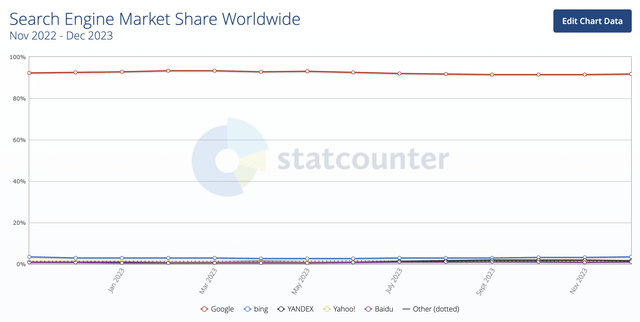 Global Search Market Share (StatCounter) Its YouTube video platform, meanwhile, is one of the largest in the world. It generated $29.2 billion in revenue in 2022 and $22.3 billion through the first 9 months of 2023. Unlike other media platforms, it doesn’t have to spend a lot on upfront content costs, instead using a revenue-sharing model with content creators. YouTube Music and Premium surpassed 80 million subscribers as of the last reported numbers in 2022. The company also serves up ads through its targeted advertising technology via Google Network, which includes AdSense, AdMob, and Google Ad Manager. Through these programs, the company will serve ads to client websites or apps based on their content, geographical location, and other factors. Google Networks generated $32.8 billion in revenue in 2022 and $23.0 billion through the first 9 months of 2023. Google Cloud is the #3 cloud infrastructure company behind leaders AWS, owned by Amazon (AMZN), and Microsoft (MSFT) Azure. It generated $26.3 billion in revenue in 2022 and $23.9 billion through the first 9 months of 2023. 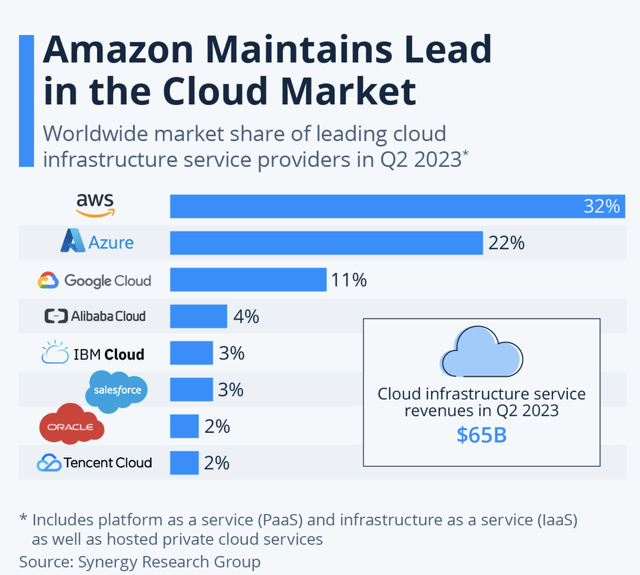 Cloud Infrastructure Market Share (Statista/Synergy Research Group) In addition, GOOGL owns the Android operating system, Gmail, the Chrome web browser, Google Classroom, navigation platforms Maps and Waze, and Google Photos, among others. It also has a hand in hardware with its Pixel smartphone, smart home product line Nest, Chromebook, and streaming device Chromecast. Finally, it is working on some more pie-in-the-sky projects such as self-driving cars (Waymo), quantum computing (Sycamore), and smart cities (Sidewalk Labs). Opportunities & RisksGOOGL has a virtual monopoly in search, which should continue to be a growth engine for the foreseeable future. Its ability to deliver performance-based ads, as opposed to brand ads, is really unmatched by most rivals. Performance-based ads are bottom of the funnel and tend to be more resilient compared to brand advertising. They have a much more direct and measurable correlation to sales, so companies like to use this type of advertising, especially when there are more concerns around the consumer. Performance advertising has also been getting a boost from the big pushes of Chinese companies like Temu, owned by PDD (PDD), and Shein, which have been trying to draw in U.S. consumers with cheap deals. Another big opportunity for GOOGL is the monetization of YouTube Short videos. With an estimated 2.7 billion active users, YouTube is already quite large. Previously, Short creators had no options to earn money from producing videos, unlike with YouTube’s long-form videos. Starting in 2023, GOOGL started sharing 45% of ad revenue with creators on its Partner Program. To qualify, creators must have 1,000 followers and 10 million Short views over 90 days. Revenue will be allocated to creators based on their share of Short views. The goal here is to incentivize creators to produce content for YouTube Shorts to compete with TikTok. Meanwhile, the better the community performs as a whole, the more money creators can earn. It is also worth noting that creators will be allowed to monetize their content when using popular music, which has been a sticking point in the past. So far, YouTube Shorts appears to be working. In July, the company noted that Short video watchers had risen from 1.5 billion to 2.0 billion in a year. Meanwhile, in October, the company said Shorts averaged 70 billion views a day and that the company was working on closing the monetization gap between long form and short form videos. Google Cloud is another opportunity for the firm. Cloud continues to be one of its strongest top-line drivers, growing around 26% so far in 2023. It has yet to turn a full-year profit yet, although it is on track to do so this year. It’s a high fixed-cost business and GOOGL is the #3 player, so it continues to need to scale the business. If Google Cloud can continue its momentum, it should be a nice bottom line driver moving forward as well. One area that GOOGL has heavily invested in is artificial intelligence ("AI") and machine learning ("ML"). It’s looking to use this tech across the company, both with search, cloud computing, and other areas. Some particular areas of focus are translation, computer vision, and natural language processing. Discussing AI at a Scotiabank Conference last month, CTO of Google Cloud Will Grannis said:
While AI is an opportunity for GOOGL it is also a risk. OpenAI's ChatGPT got a lot of buzz in 2023, and rival MSFT made a $10 billion investment into the AI firm and incorporated its tech into its products, including Azure, Microsoft 365, and its search engine Bing. That upped the game and may have rushed GOOGL into an AI race before it wanted to be in one. The biggest risk from AI likely isn’t MSFT and ChatGPT, but from GOOGL cannibalizing its own revenue. If users can get information they need directly from Google without having to visit websites, it could potentially lead to less clicks on relevant ads. The counter argument is that it could lead to more use of the Google search engine, and that Google could benefit from more impressions while the company could create new forms of ads to benefit from AI answers. Outside on AI and technology disruption, the macroeconomy is another risk. As a leader in search and video, GOOGL makes the bulk of its money from advertising. As such, the company isn’t immune to a slowdown in ad spending. Unlike in the past where the secular trend could easily outpace any macro weakness, that isn’t necessarily the case anymore. Meanwhile, while Google Cloud has started to turn profitable, there is no guarantee that this will continue. You have three huge companies fighting for market share that could be willing to compete on price if necessary. AMZN’s AWS growth and operating margins have both fallen so far this year. Through the first 9 months to the year, its operating margins were 26.2% versus 30.0% last year. Growth so far in 2023, meanwhile, was 11% versus 32% during the same period in 2022. There is no doubt AMZN will try to fight back, and it has shown a willingness to sacrifice some margin to do so in the past. Regulation is another risk. The company has paid out a number of recent legal settlements recently. It recently agreed to pay $700 million and allow developers to offer direct payments on its Play app. It also settled a $5 billion lawsuit, terms not disclosed, in a privacy lawsuit because it tracked people who were viewing in private modes. Late last year, it reached a $391.5 million settlement with 40 states related to tracking personal data. The big risk, though, is the current DOJ case against the company that it is a monopoly that illegally used its power to its benefit. A loss could lead to a huge fine, a change in business practices, and a damage to brand reputation. It also would likely be followed by a similar case in Europe. Legal risks are always among the most difficult to quantify. ValuationGOOGL currently trades at about 11.5x 2024 EBITDA estimates of $139.9 billion. Stripping out its approximately $4.5 billion in losses on Other bets, the core business is only trading a 11.2x EBITDA. Based on the current 2025 EBITDA consensus of $158.3 billion, the stock trades at a 10.2x multiple. Revenue is projected to grow 11.3% in 2024 and 10.9% in 2025. The company has rebounded well this year, with revenue growth accelerating through the year, up 6% in constant currencies in Q1, 9% in Q2, and 11% last quarter. It also expanded its operating margin to 28% in Q3 from 25% a year ago. GOOGL currently has a free cash flow yield of about 4.4% based on FCF of $77.5 billion in the last trailing twelve months. GOOGL is among the cheaper mega-cap tech stocks. 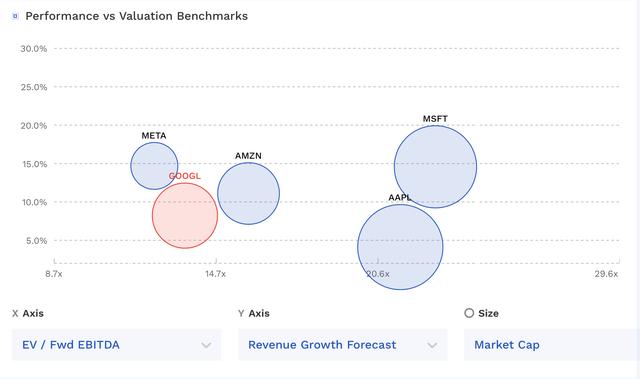 GOOGL Valuation Vs Peers (FinBox) To get to a year-end 2024 fair value, I’d place between a 12-15x multiple of 2025 EBITDA for GOOGL, while assuming it adds about $75 billion in cash to its balance sheet or returns it shareholders through buybacks. That equates to a fair valuation range between $175-207. ConclusionWhen it comes to technology, there is always the risk of disruption. It’s a common theme in tech that new upstarts eventually come along and disrupt incumbents. Starting from scratch gives these upstarts a huge advantage, as legacy incumbents are often weighed down by past designs and infrastructure investments that lead to inefficiencies as technologies shift. However, the fact that GOOGL has been built on its own flexible infrastructure helps protect it. The company also pours money into research and development to potentially “disrupt” itself. They are at the point where this is starting to play out, but GOOGL appears to be well prepared. GOOGL’s virtual monopoly on search is reason enough to own the stock at current levels. It is one of the largest and most dominant companies in the world. However, the company doesn’t sit on its laurels and continually looks at new products, services, and monetization efforts to drive growth. Longevity can be the biggest question around tech companies as they mature - it’s one reason why Warren Buffett has tended to avoid the sector. However, GOOGL has built a platform focused on simplicity and flexibility, which should allow it to endure and continue to prosper. At the same time, it continually pumps money into R&D to both drive growth and to help future proof itself. If you look at the number of products, services, and apps GOOGL offers, it’s actually quite staggering. GOOGL products are really ingrained in their everyday lives and often in their work lives as well. And it is GOOGL’s ability to continually innovate that will really drive growth moving forward. As such, I consider GOOGL a core, long-term holding. I have a “Buy” rating and $190 price target on the stock. The Pixel Buds Pro represented a major leap forward for the Google Pixel Bud family, delivering high-end features like ANC and IPX4 water resistance. They had a lot of positive things to say about Google’s flagship true wireless earbuds, but that’s not to say they were perfect. Below is my wishlist for what I’d like to see from the Google Pixel Buds Pro 2.
A better fit would go a long wayLily Katz / Android Authority It doesn’t matter how great a pair of earbuds is if they don’t fit comfortably. While the Pixel Buds Pro earbuds are reasonably comfortable, a common complaint is that they always feel a bit loose. Google offers three different earbud tips, but no matter which one you use, you’ll never achieve as snug a fit as with other headphones. Some ear shapes may struggle with the buds falling out, but for most, they just feel a bit loose. Google needs to address this design flaw with the Pixel Buds Pro 2. Considering that other Pixel Buds models haven’t had this issue, they would expect this to be an easy fix.
Transparency mode could use improvementsRyan Haines / Android Authority The inclusion of a transparency mode is awesome, and for the most part it works fine, but it falls short of the natural, airy sensation you’d get with something like the AirPods Pro. What’s currently hindering transparency mode? It’s likely due to the absence of the spatial vent found on other Pixel Buds, which allows more natural, ambient sound to come through. A straightforward solution would be for Google to redesign its Pixel Buds Pro 2 to be more in line with other models. The earbud’s fit and its transparency mode have both been compromised with the current design, indicating a clear need for a change.
Support for aptX and other missing codecsRyan Haines / Android Authority The Google Pixel Buds Pro supports only AAC and SBC for Bluetooth codecs, lacking other advanced codecs. This absence is particularly notable for earbuds priced around $200, as most competitors in this range offer at least aptX or LDAC support. For the Pixel Buds Pro 2, Google needs to embrace other advanced codecs to give consumers more options, with aptX being a minimum expectation.
Improved micWhile the Pixel Buds Pro has decent microphones that work well in ideal conditions, they struggle in noisy environments with noise rejection. You’ll find it will work fine in Zoom meetings or while having a quick chat, but it will perform less admirably in a chaotic office. True wireless earbuds are often popular choices for a jog or a run, but the Buds Pro isn’t so great here if you plan on taking a call outside. Wind noises will get in the way, and for those with higher voices, you’ll likely have whole sections of your voice drop off. The Google Pixel Buds Pro 2 should Improve noise rejection and audio quality with its mic to ensure it lives up to the Pro name.
A lower price tag would be niceRita El Khoury / Android Authority The Google Pixel Buds Pro initially retailed for $199.99 but haver seen frequent sales, dropping to as low as $120 during the holiday season. While these discounts are appealing, Google overpriced the earbuds to begin with. When the Pixel Buds Pro came out, they were considered a tad expensive by many reviewers when comparing their feature set to other earbuds around the same price range. There’s a recurring pattern of Google reducing prices shortly after product launches, a practice that can be perceived as price-gouging against us early adopters. A good example is its Pixel phones, which often launch at one price only to be cut back by as much as hundreds within a few months. We’ve seen similar practices with its smart home products, too. To be fair, Samsung and others also have price cuts, but usually, they are not as substantial until very close to the end of a generation’s life. Google tends to cut pricing by as much as a quarter within the first half of a product’s lifecycle. Just give us a low price to begin with! I’d like to see the Pixel Buds Pro 2 get a bit more aggressive to win over more fans to its audio products, pricing it around say $150-$175. This might tempt those of us who have become aware of Google’s sales tactics into buying sooner. More sales at launch means more exposure by word of mouth and so forth.
Will there be a Google Pixel Buds Pro 2?Lily Katz / Android Authority
The Google Pixel Buds series has had a somewhat mixed reception. Google doesn’t give solid numbers on how products like these perform, but the headphones seem to have a small and growing fanbase. While it seems unlikely that Google will exit the audio space immediately, they have a history of axing products that don’t do as well as they initially hoped. For that reason alone, all I can say the Google Pixel Buds Pro 2 are likely but not guaranteed. Predicting when they might arrive is even harder, though. As for the Pixel Buds Pro 2 release date? We’re likely a long way off. Looking back at the company’s history, it’s hard to draw firm conclusions but they can at least attempt. The company originally released the Pixel Buds in October 2017 and followed it up with a second-generation model in October 2019. Since then, there hasn’t been a new model under the Pixel Buds brand directly. There was a mid-range Pixel Buds A Series in June 2021 and the Pro version a year later in May 2022. Given this pattern, it’s plausible that Google will unveil a new audio product in 2024, as they typically release something every two years. The nature of this release is less certain. It could be a follow-up to the Pixel Buds A Series, Pixel Buds 3, or another Pro variant. While 2024 is a possibility, 2025 might be a more likely timeframe unless Google ends up releasing more than one model at the same time.
Should you wait for the Google Pixel Buds Pro 2?Lily Katz / Android Authority The Google Pixel Buds Pro 2 are only a year old and can now be found on sale for well under $150. If you are a Pixel fan and want to get the buds for better brand consistency, there’s no reason to wait out for the next Pixel Buds model. Yes, there might be something in 2024, but it may be a more mid-range option. Google Pixel Buds Pro
Google Pixel Buds Pro Active noise-cancelling • Android integration • Google Assistant features The Pixel Buds Pro introduce ANC to the series The Google Pixel Buds Pro are the first in the line to offer active noise canceling. Obviously, they also have tight integration with Android and tons of support for Google Assistant commands, including the popular translation features. The only exception is if there’s a feature you really want that isn’t available on the Pixel Buds Pro. If you aren’t impressed by the Buds Pro, you could wait until mid-2024 and see if Google’s next buds address the problem. Of course, it’ll likely be mid-range hardware, and so even if it improves fit, pricing, and other factors — it’ll also be missing some of the improved Pro features. Don’t mind shopping outside of Camp Google? For those looking for a similar experience and cost, the most obvious alternatives to the Pixel Buds Pro are the Samsung Galaxy Buds 2 Pro ($179 at Amazon), which cost around $179 retail and can be found for a little less during the holidays. You’ll get better audio codec support and a better fit, though some of their best features are exclusive to Samsung phone owners. If you don’t mind spending a bit more, the Sony WF-1000XM5 ($298 at Amazon) or 2nd gen Apple AirPods Pro ($189 at Amazon) are also easy recommendations. | ||||||||
Google-PDE teaching | Google-PDE exam syllabus | Google-PDE syllabus | Google-PDE course outline | Google-PDE outline | Google-PDE information | Google-PDE PDF Download | Google-PDE information | Google-PDE test | Google-PDE study help | | ||||||||
Killexams exam Simulator Killexams Questions and Answers Killexams Exams List Search Exams |
Google-PDE Reviews by Customers
Customer Reviews help to evaluate the exam performance in real test. Here all the reviews, reputation, success stories and ripoff reports provided.
100% Valid and Up to Date Google-PDE Exam Questions
We hereby announce with the collaboration of world's leader in Certification Exam Dumps and Real Exam Questions with Practice Tests that, we offer Real Exam Questions of thousands of Certification Exams Free PDF with up to date VCE exam simulator Software.









